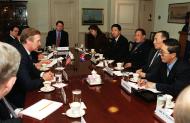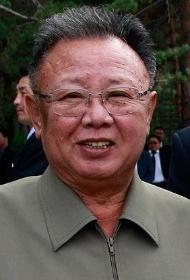谁和金玉 (金正日妻子)约会过?
Kim Jong-il 日期为 金玉 (金正日妻子),从 到 . 年龄差距为 23 年 6 个月零 12 天.
金玉 (金正日妻子)

金玉(韓語:김옥,羅馬化:Kim Ok,1964年8月28日—),是朝鮮民主主義人民共和國的第二代最高領導人、前朝鮮勞動黨總書記金正日的第五任妻子,即現任朝鮮劳动党总书记金正恩的繼母。
她畢業於平壤音樂舞蹈大學,主修鋼琴。金正日廚師日本人藤本健二曾親眼見過20多歲時的金玉,他形容其人「皮膚白皙,臉型小,身高158公分,身材很出眾,長得像日本女星宮澤理惠。」在1980年代起金玉擔任金正日的「技術書記」,相當於其私人女秘書,更負責管理金正日的金庫。《朝鮮日報》指她在金正日第四任妻子高英姬死後,與金正日同居。她有時會隨金正日外訪,例如在2006年1月就以朝鮮國防委員會課長的名義陪同金正日到中國訪問中共中央總書記、國家主席胡錦濤。
有傳2008年年中金正日健康惡化,在2008年底至2009年初有所恢復後,二人正式結婚,並育有一名年幼兒子。之後在數個重要場合都能看到她出現,例如2010年9月金正恩在朝鮮勞動黨代表會議被確立為金正日繼承人之後,在領導人集體照中可見金玉亦有合影。她更擔任朝鮮人民軍創建七十五周年閱兵儀式排練的總指揮。
關於她和金正恩的關係,外間有各種不同揣測:有指金正恩的生母高英姬在臨終前向金玉托孤;也有指她有份參與指定金正恩為繼承人,因對方年輕,有利於她日後幕後掌權;更有指金玉實際上才是金正恩的生母。然而,也有另一種傳聞指,金玉由於屬於黨內的溫和派,已被掌權後的金正恩肅清。
阅读全文...Kim Jong-il

Kim Jong Il (born Yuri Kim; 16 February 1941 or 1942 – 17 December 2011) was a North Korean politician and dictator who was the second supreme leader of North Korea from the death of his father Kim Il Sung in 1994 until his death in 2011. Posthumously, Kim Jong Il was declared Eternal General Secretary of the Workers' Party of Korea (WPK).
In the early 1980s, Kim had become the heir apparent for the leadership of North Korea, thus being established the Kim family, and he assumed important posts in party and army organizations. Kim succeeded his father and founder of North Korea, Kim Il Sung, following his death in 1994. Kim was the General Secretary of the WPK, WPK Presidium, WPK Central Military Commission, Chairman of the National Defence Commission (NDC) of North Korea and the Supreme Commander of the Korean People's Army (KPA), the fourth-largest standing army in the world.
Kim ruled North Korea as a repressive and totalitarian dictatorship. Kim assumed leadership during a period of catastrophic economic crisis amidst the dissolution of the Soviet Union, on which it was heavily dependent for trade in food and other supplies, which brought a famine. While the famine had ended by the late 1990s, food scarcity continued to be a problem throughout his tenure. Kim strengthened the role of the military by his Songun ("military-first") policies, making the army the central organizer of civil society. Kim's rule also saw tentative economic reforms, including the opening of the Kaesong Industrial Park in 2003. Under his leadership, North Korea conducted its first nuclear test in October 2006, obtaining nuclear weapons. In April 2009, North Korea's constitution was amended to refer to him and his successors as the "supreme leader of the DPRK".
The most common colloquial title given to Kim during his lifetime was "Dear Leader" to distinguish him from his father Kim Il Sung, the "Great Leader". Following Kim's failure to appear at important public events in 2008, foreign observers assumed that Kim had either fallen seriously ill or died. On 19 December 2011, the North Korean government announced that he had died two days earlier, whereupon his third son, Kim Jong Un, was promoted to a senior position in the ruling WPK and succeeded him. After his death, alongside "Eternal General Secretary" of the WPK, Kim Jong Il was declared "Eternal Chairman" of the now defunct National Defence Commission, in keeping with the tradition of establishing eternal posts for the dead members of the Kim dynasty. North Korean media also began referring to Kim as "the General" (장군 Changgun), similar to his father's posthumous designation as "the [eternal] President".
阅读全文...